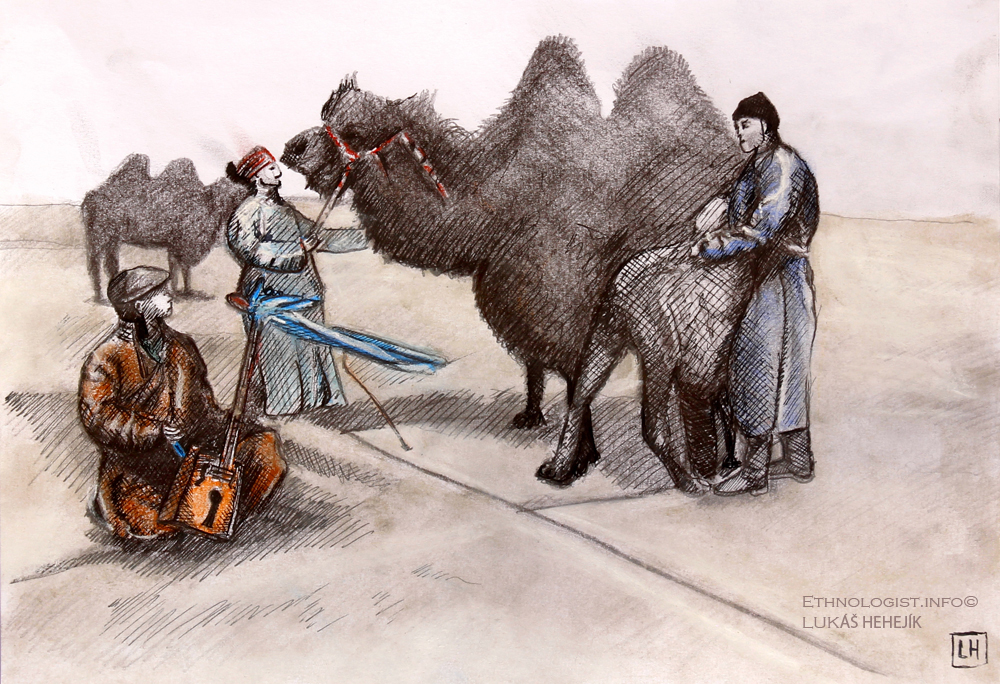There is a unique custom in Mongolia, by which pastoralists could ´coax´ the female camel to become affiliated with the orphan calve or re-affiliated with the rejected calve. Recently, this ritual has been included on the List of Intangible Cultural Heritage in Need of Urgent Safeguarding UNESCO.

Mongolia is a country of boundless steppes, herders and nomads, descendants of the infamous Genghis Khan, who have successfully adapted to the specific natural conditions. The latter has specialised in the capability of rearing a great numbers of animals and migrating throughout a widespread area to seek fresh feed. The nomadic way of life has always depended upon the animals, and the abundant herds have always been the alpha and omega of the migrating Mongols. The interconnectedness with the surrounding environment and animals has been reflected in the material and spiritual culture of the Mongols.
One of the most remarkable Mongolian custom is the so-called ´coaxing ritual for camels´, in Mongolian known as inge khööslökh (mng. ингэ хөөслөх, ингэ – female camel). It when a female camel is rejecting her new-born calf, or in the occurrence of the need to adopt an orphaned calf. The rite is performed by playing on a two-stringed instrument, known as a morin khuur, and singing the khöös (mng. хөөс) song. The intention of this outstanding ceremony is to coax a female camel into adopting the calf. At the beginning, the female camel could be aggressive, but the melody gradually induce deep feelings and so touches her. She begins to cry and eventually she will adopt the calf as her own. What is more, it is said that there can be seen real teardrops in the female camel´s eyes.
As incredible as it may sound, this is a factual rite, which still takes place on the Mongolian steppes. This ritual was also shown in the 2003 movie ´Die Geschichte vom weinenden Kamel´1.The story of the Weeping Camel (director L. Falorni, B. Davaa), a German-Mongolian co-production. This half-documentary and half recreated drama is a work from graduates of the University of Television and Film (HFF/M) in Munich and was nominated for the European Film Award in the documentary category, as well as being screened at a numbers of prestigious film festivals. The story line takes place in the Southern Mongolian Gobi Desert, where a calf was born in spring with unusual white coat. Then, due to the difficult circumstances during birth, the mother camel rejects the new-born calf. The pastoral family tries to restore the bond between mother and calf and they reach out to a teacher of playing the morin khuur from a faraway area to ask for a help. Finally, the coaxing ritual takes place and after the female camel sheds a tear, she begins to feed the calf. The film has had great success, although it is essentially a reworking of the famous 1986 Mongolian documentary, Ingen egshig directed by N. Žancannorov, which won an award at the International Film Festival in Moscow in 1988.
The ritual of khööslökh is more common in the desert areas, where people herd large numbers of camels. This area includes the Mongolian administrative provinces of aimags Dundgovi Province, Ömnögovi Province and Bayankhongor Province. The performing of the custom is slightly different, depending on the particular area, as well as the way of playing and singing, which is linked to the behaviour of the female camel. It follows that that the ritual could consist of just playing the morin khuur, but sometimes it is necessary to sing heart touching songs; ´khöös´, and at other times the songs are spontaneous melodies, according to a particular string instrument.
The same custom also includes other farm animals, such as sheep or goats. Nevertheless, greater importance is placed on the camels, as nomadic culture seems them as prized and animals worthy of reward. There is a Bactrian camel (Camelus bactrianus) in Mongolia, which is primarily used for transport, a necessity in these remote areas. One animal has the capability of carrying approximately from 100 to 200 kilograms and can walk 30 or 40 kilometres per day. The camel is very strong and has twice the tensile strength of an ox. This nomadic society appreciates camels mainly for wool or milk, and, to a lesser extent, for meat. The other important commodity is camel droppings, which are used as fuel. Furthermore, the camel has the ability to graze on plants that are refused by other animals. It must be borne in mind that camels give birth to only one calf every two years and the loss of even one camel is a huge loss for the herders. The Mongols thus consequently found a unique method to prevent it.
Nowadays, unfortunately, this exceptional tradition of coaxing camels is maintained by only a few Mongolian pastoralists. The knowledge of this ritual inge khööslökh is passed on to younger generations, but due to modern urbanization, and perhaps the westernization of Mongolia, it is slowly beginning to vanish. Indeed the time was right to include the coaxing ritual for camels on the list of UNESCO.
Interesting links:
“Coaxing ritual for baby camels” registred in UNESCO Heritage List (Embassy of Mongolia in the United Kingdom)
The story of the Weeping Camel (Film info; German Films)
UNESCO – World Heritage Centre
Illustrator: Lukas Hehejik
Translator: Barbora Sajmovicova
Proofreader: Daniel Irvine
| ↑1 | The story of the Weeping Camel |
|---|